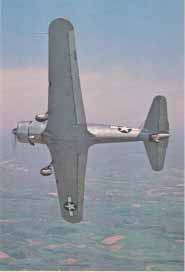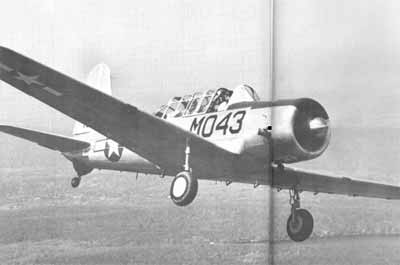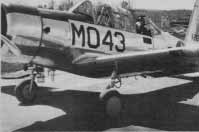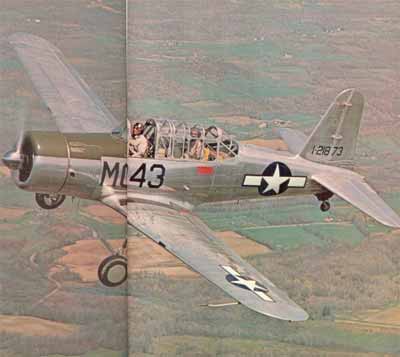PAGE THREE
Visibility, aside from the caged-in feeling of the canopy frames, was
fantastic, and the comfort was something else. We were indicating
something in the neighborhood of 130 to 135 mph, which isn't exactly
screaming, when you consider you have 450 ponies working for
you. Then too, it wasn't built to go steaming around the countryside,
it was built to teach as it went, and naturally, that takes time.
 |
In planform the difference
between the BT and the Texan is more obvious. |
Noticing the
placard giving entry speeds for various idiotic goodies, I dropped the nose and
pulled up into a big, lazy barrel roll. It had to be lazy, because that's about
the only way the Vultee knows how to roll. It runs just a little short of aileron,
which means you have to take your time doing rolls. That's not a bad trait, nor
even a nuisance, and if you rationalize hard enough, you'll find it even
adds some grace to the maneuvers.
The stalls are interesting because the buffet is anything but subtle.
It feels as if a gremlin is trying to chin himself on the elevators.
The elevators bang and jump and set up all sorts of commotion, letting
you know you're about to do something dumb. When it does unload, down
around 70 mph or so, the left wing breaks first, and you have to get
forward stick and power immediately to keep the wing from tucking under.
There are all sorts of stories about cadets spinning in while flying
the pattern. I can see why it would spin it you let it stall, but I
don't see why they stalled it in the first place, unless they were sitting
on their hands.
I guess I suffer from the same if-it's-military, it's-hard-to-land syndrome
as most people, so I was anticipating all sorts of problems. I always
expect airplanes like the BT to turn around and bite my leg like an
unruly horse while landing. In that frame of mind, I attend to business while
landing like a nervous accountant, making sure everything is letter
perfect. Another placard said 80 mph for approach, so I fixed that figure in
my mind as I turned onto down-wind at 110 mph and went through a GUMP check:
gas (right tank), undercarriage (down and welded), mixture (forward),
propeller (full rpm). As I moved the propeller pitch forward, I could
visualize people in the town below looking up at the tremendous racket
we were making. Even though I had the throttle way back. I knew we
weren't making any friends out of the non-flyers down there.
While still on downwind, I grabbed the flap crank and started counting—one,
two, three, four, etc. I wanted 20 degrees, which meant 10 cranks.
I glanced back at both boards to see that they were out and brought
the horsepower lever hack to start our descent. On my first landing,
I was a little high and had to kill it completely to get down, and
then I didn't flare high enough. I wanted to wheel it on (chicken's
way out). but I misjudged and hit sooner than I expected, but still
didn't bounce. Later I found it simple to level out and wait until
the mains touched before pinning them on with forward pressure.
The rudder seemed to be doing its thing, and even though there was a
crosswind, I had little or no trouble keeping in the vicinity of the
centerline. At no time, from final on down, did I have anytrouble seeing
over the nose.
Then I started doing three-points. These were equally easy, but I found
that you if you didn’t flair high enough, you’d get a pretty
good bounce when you skipped off the mains, which is no different than
other taildraggers.
Also, it sheds speed like crazy when the nose is brought up, so you'd
better be close to the ground if you plan to do much pulling, especially
with a lot of flaps hanging out.
 |
I still like the looks of
the old airplane, don't you? |
Roll-out, whether three-point or wheel, is surprisingly
stable and sweat free. It doesn't really want to do anything except
roll straight ahead, and, if it does do a little sashaying, the steerable
tailwheel and rudder take care of it so quickly that it would take
some doing to get in trouble.
Like most military aircraft, the BT-13 is a bird headed for certain extinction.
Of the more than 11,000 built, only a handful remain, the rest being
cannibalized, their engines running out their days dusting crops and
their skins corroding in forgotten fields. It's not a working
airplane like the PT-17 Stearman, nor does it possess the performance
and sophistication of the AT-6. It has qualities all its own, but you
have to look close to see them. It will let its driver bask in the
glory and feeling of the now exalted warbirds without any of the operational
or financial headaches.
The BT-13 is the first airplane I ever sat in, and it is directly responsible
for my getting into this flying game. Bill Riddle presented me with
an opportunity too good to miss, so I tossed my young son up into the
back seat, making it two generations of Davissons that have started
their careers in Vultees. Maybe years from now he'll ask me if there
are still any of those big old silver airplanes around, like the one
he sat in, and I'm afraid I'll have to tell him they are all gone.
 |
 |
Editor's Note about the two
pictures above: The picture
on the left was shot next to my dad's store in Seward, Nebraska in
1948. That's my older sister in the front seat, me in the back seat
and my late brother down by the wheel. Dad had the airplane flown in
and my first airplane ride was in the back seat with it coming backwards
down Highway 25 with the tail in a pick-up heading for the store. The
military smell of that airplane is still with me today.
It's hard to tell, but the right picture has me in the backset again,
but this time, my now-37 year-old-son, Scott is in my lap at six monthes
of age. Sort of a cool combination of shots isn't it?
FOR MORE PILOT REPORTS
LIKE THIS ONE CLICK HERE
|

